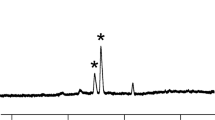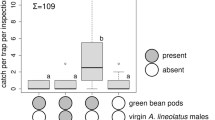Abstract
Both sexes of adult western tarnished plant bug, Lygus hesperus Knight (Heteroptera: Miridae), released three volatile chemicals in relatively large amounts when attacked by ants (Pogonomyrmex rugosus and Solenopsis xyloni) or when grabbed by forceps, as determined by solid-phase microextraction (SPME) and gas chromatography–mass spectrometry (GC–MS). The relative amounts of the volatile compounds, hexyl butyrate, (E)-4-oxo-2-hexenal, and (E)-2-hexenyl butyrate, absorbed by SPME as a percentage of the largest were 100%, 44%, and 4%, respectively, from females, and 83%, 37%, and 3% from males. Both ant species were repelled by the defensive discharges (confirmed by SPME) when the ants attacked L. hesperus adults. Sexually mature L. hesperus were individually extracted in pentane to quantify the mean amounts of hexyl butyrate (14.9 μg/female; 10.3 μg/male), (E)-4-oxo-2-hexenal (2.7 μg/female; 3.1 μg/male), and (E)-2-hexenyl butyrate (1.2 μg/female; 0.6 μg/male). (E)-4-Oxo-2-hexenal was unstable in solvent when in contact with a macerated adult, but relatively stable when the solution was decanted within minutes. The production of the three major volatile components began soon after the emergence of the adult and amounts increased for about 5–10 d with little or no increase thereafter. Minor additional constituents were cross-correlated in many cases with the three major ones. A cost of defensive secretion is suggested for females but not for males, because heavier females produced more volatile compounds than lighter females. The initial discharge percentage, defined as the proportion of volatile compounds initially present that is discharged to defend against predation was estimated at about 50% in males and 70% in females. Newly eclosed adults did not produce volatile chemicals until 2 d after molting.



Similar content being viewed by others
References
Aldrich, J. R., Lusby, W. R., Kochansky, J. P., Hoffmann, L. T., Wilson, F. G., and Zalom, F. G. 1988. Lygus bug pheromones, vis-à-vis stink bugs. Proceedings Beltwide Cotton Production Research Conferences. pp. 213–216.
Birgersson, G., Schlyter, F., and Bergström, G. 1988. Individual variation in aggregation pheromone content of the bark beetle, Ips typographus. J. Chem. Ecol. 14:1737–1761.
Blackmer, J. L., Rodriguez-Saona, C., Byers, J. A., Shope, K. L., and Smith, J. P. 2004. Behavioral response of Lygus hesperus to conspecifics and headspace volatiles of alfalfa in a Y-tube olfactometer. J. Chem. Ecol. 30:1547–1564.
Byers, J. A. 2005. A cost of alarm pheromone production in cotton aphids, Aphis gossypii. Naturwissenschaften 92:69–72.
Clancy, D. W. and Pierce, H. D. 1966. Natural enemies of some Lygus bugs. J. Econ. Entomol. 59:853–858.
Debolt, J. W. and Patana, R. 1985. Lygus hesperus, pp 329–338, in P. Singh and R. F. Moore (eds.). Handbook of Insect Rearing, Vol. 1. Elsevier, New York.
Graham, H. M. 1987. Attraction of Lygus spp. males by conspecific and congeneric females. Southwest. Entomol. 12:147–154.
Graham, H.M. 1988. Sexual attraction of Lygus hesperus Knight. Southwest. Entomol. 13:31–37.
Ho, H.-Y. and Millar, J. G. 2002. Identification, electroantennogram screening, and field bioassays of volatile chemicals from Lygus hesperus Knight (Heteroptera: Miridae). Zool. Studies 41:311–320.
Kelton, L. A. 1975. The Lygus bugs (genus Lygus Hahn) of North America (Heteroptera: Miridae). Mem. Entomol. Soc. Can. 95:1–101.
Krall, B. S., Bartelt, R. J., Lewis, C. J., and Whitman, D. W. 1999. Chemical defense in the stink bug Cosmopepla bimaculata. J. Chem. Ecol. 25:2477–2494.
McGurk, D. J., Frost, J., Eisenbraun, E. J., Vick, K., Drew, W. A., and Young, J. 1966. Volatile compounds in ants: Identification of 4-methyl-3-heptanone from Pogonomyrmex ants. J. Insect Physiol. 12:1435–1441.
McLaughlin, J. R. 1996. Population monitoring of Lygus hesperus with female baited traps. Proceedings Beltwide Cotton Production Research Conferences. pp. 733–734.
Pureswaran, D. S. and Borden, J. H. 2003. Is bigger better? Size and pheromone production in the mountain pine beetle, Dendroctonus ponderosae Hopkins (Coleoptera: Scolytidae). J. Insect Behav. 16:765–782.
Rodriguez-Saona, C., Crafts-Bradner, S. J., Williams, L. III, and Paré, P. W. 2002. Lygus hesperus feeding and salivary gland extracts induce volatile emissions in plants. J. Chem. Ecol. 28:1733–1747.
Sappington, T. W. and Taylor, O. R. 1990. Developmental and environmental sources of pheromone variation in Colias eurytheme butterflies. J. Chem. Ecol. 16:2771–2786.
Scales, A. L. 1968. Female tarnished plant bugs attract males. J. Econ. Entomol. 61:1466–1467.
Scott, D. R. 1977. An annotated listing of host plants of Lygus hesperus Knight. Bull. Entomol. Soc. Am. 23:19–22.
Sokal, R. R. and Rohlf, F. J. 1995. Biometry. 3rd edition, W.H. Freeman and Company, New York.
Strong, F. E., Sheldahl, J. A., Hughes, P. R., and Hussein, E. M. K. 1970. Reproductive biology of Lygus hesperus Knight. Hilgardia 40:105–147.
Wardle, A. R., Borden, J. H., Pierce, H. D. Jr., and Gries, R. 2003. Volatile compounds released by disturbed and calm adults of the tarnished plant bug, Lygus lineolaris. J. Chem. Ecol. 29:931–944.
Acknowledgments
I thank Dan Langhorst and LeAnne Elhoff for maintaining the colonies of tarnished plant bugs; LeAnne Elhoff for technical assistance; and Jackie Blackmer, Hollis Flint, and the Journal’s review process for helping improve the manuscript.
Author information
Authors and Affiliations
Corresponding author
Rights and permissions
About this article
Cite this article
Byers, J.A. Production and Predator-Induced Release of Volatile Chemicals by the Plant Bug Lygus hesperus . J Chem Ecol 32, 2205–2218 (2006). https://doi.org/10.1007/s10886-006-9140-x
Published:
Issue Date:
DOI: https://doi.org/10.1007/s10886-006-9140-x




